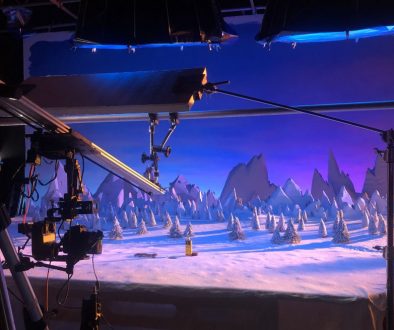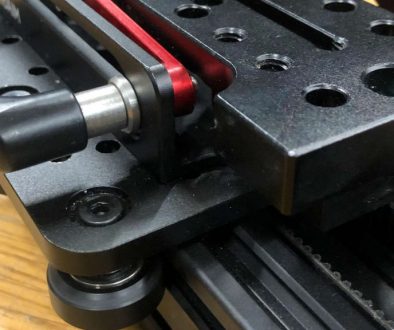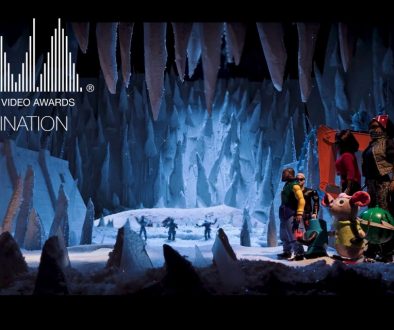Cat Stevens Stopmotion Music Video
Well, with the old team reassembled the challenge was to top our previous award-winning music video. This time creating an environmentally friendly production for re-recording of a classic track by the artist Yusuf/Cat Stevens. It seemed a tall order when Jon, the other cinematographer and I were brought in and we first set eyes on the storyboards. We were three days out from having to start shooting the first frames and we needed to build the studio from scratch still! Jon and I still even had to put in the electrics at that point, as we wanted to run dedicated power for the lighting to try to avoid as much flicker as possible. This was certainly a very ambitious project with a lot of different setups running on multiple sets in a very short time.



“Our sea scenes were made from waste plastic washed up on our shores,” says Ridley Scott associates director Chris Hopewell. “All of the sets and practically all props were made from recycled repurposed and upcycled materials. I’d say that 90% of what you see on screen was made from recycled materials, even the rostrum the sets are built on were recycled scaffolding planks and sets painted with paints from a local charity store. All materials used were then repurposed or recycled when the video was finished. It was a slightly longer process than usual, but fun!”
Animation has a
universal appeal

As the director points out, animation has a universal appeal – and can prove a powerful tool in helping people visualise future scenarios or abstract concepts. “I think animation appeals to everyone…. It’s a very universal medium in which there’s often no need for dialogue. The picture tells all.”
This year marks the 50th anniversary of the release of Cat Stevens’ classic album, Tea for the Tillerman. Created following a decade defined by war, protest and environmental disasters, the album – which includes the tracks Father & Son and Wild World – had a profound impact on popular culture. Its release saw Cat Stevens become one of the 1970s’ most successful and influential singer-songwriters and the record has since earned a place on numerous ‘best albums of all time’ lists.
Yusef/Cat Stevens has re-recorded his landmark 1970 LP Tea For the Tillerman in honour of its 50th anniversary. It comes out on September 18th 2020, but he’s just released a video for his new take on “Where Do the Children Play?” Watch the full Cat Stevens video above.
While its setting is bleak, the film features some charming moments and playful touches and ends on a more optimistic note – reinforcing the idea that it’s not too late to create positive change. The use of animation allowed Hopewell and Yusuf to deliver a serious message with lightness and humour – something that Hopewell believes was important in getting people to connect with the film.
“An element of humour is important when dealing with environmental issues as some people can feel turned off when they feel they’re being talked at by ‘virtuous killjoys’. If you put your case with humour people are always more receptive,” says Hopewell.


For each lighting setup, I will make notes and create a rough sketch. Hopefully, we won’t need to recreate a setup, but it will come in handy when shooting out of sequence to know what gels I have on a key for example. I will often also do a quick film on my phone just to show lighting and stand placement. (featured)
We were two-handed on this shoot so on the large scale main unit setups me and Jon would light and I would then crack into lighting the second unit shots. This meant that most of the close-ups and interiors are my lighting ideas such as the furnace and big wheel. I was pretty much given a free hand with the only direction being ‘make it dark”. Despite the furnace/factory being one of these such shots on the smaller set, it ended up being somewhat complex from a lighting point of view, with a real mix of practical set lights such as the little bulkhead red lights I made, plus some red gelled LED panels embedded in the set I used to uplight some of the pipework in the background. I’m a strong believer in keeping this as simple as possible, however, I think I was up to around 15+ lights on this little set.



Jacknife Films – Ridley Scott Associates, Black Dog Films
Director – Chris Hopewell
Producers – Rosie Lea & Andy Stewart
Directors of Photography – Jon Davey, Philip M Powell
Camera Assistant – Harry Louie Jenkins
Editor & Colourist – Tom Weller
VFX & Compositing – Stevie Ryan
Additional Compositing – Jon Davey, Tom Weller
Animators – Cadi Catlow, Jacky Howson, Paul Couvela
Models – Louis McNamara, Siobhan Raw, Elaine Andrew, Beck Prior, Lucy Roberts, Joshua Hughes-Games, Jonathan Minto, Bill Brind, Chloe Moore
Backdrops – Holly Jo Beck




